Click on a small block icon for a short cut to the block that interests you. For X stars without center seams, click here:
Rocky Road to Kansas
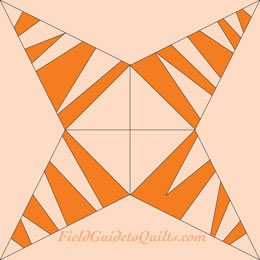 Rocky Road Rocky Road
to Kansas
LAC #236, 1897 Scrap-quilt, string-quilt, and crazy-quilt fans will love this block for the random patchwork of stripes in each triangular star point. Scrap-quilt, string-quilt, and crazy-quilt fans will love this block for the random patchwork of stripes in each triangular star point.
It was the Ladies Art Company's #236, published in the 1897 catalog, and it is laid out on a 4x4 grid. Somehow, quilters knew from the start that the irregular star-point stripes are made of scraps.
The MakeIt! icon links to freshlemonsquilts.com, where the instructions show straight stripes for the star points. You can use the same tutorial to make the LAC's version -- more fun, if you ask us, and perfect for scraps.
|
|
|
Rocky Road to Kansas
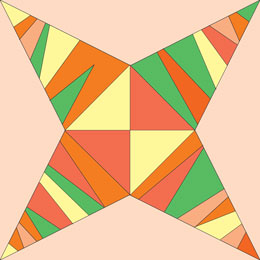 Rocky Road Rocky Road
to Kansas
Hall,
1935  In layout, the two Rocky Road to Kansas blocks are identical, but quilt researcher Carrie Hall used two colors in the center of hers in a layout that quilters call quarter-square triangles. In layout, the two Rocky Road to Kansas blocks are identical, but quilt researcher Carrie Hall used two colors in the center of hers in a layout that quilters call quarter-square triangles.
Carrie Hall stitched up an example block, which is now at the Spencer Museum at the University of Kansas. Hall's example was colorful, unlike the LAC's — which was, after all, printed in black and white.
Havig p. 61
|
|
|
Kite
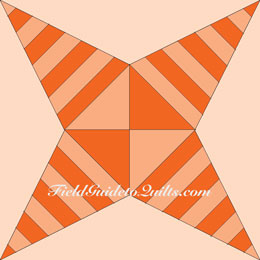 Kite
Stone Kite
Stone
1906
We think it would look terrific with any bold fabric with a stripe effect, plaids included.
Stone #85, p. 17
|
|
|
Teddy's Choice
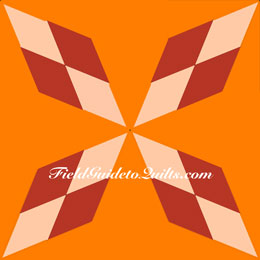 Teddy's Choice
Stone Teddy's Choice
Stone
1906
The earliest published Cowboy's Star block dates back to 1906, when Clara Stone called it Teddy's Choice for then-president Theodore Roosevelt.
Stone's graphic doesn't show any seams; otherwise, it's identical to later Cowboy's Star blocks.
The name Cowboy's Star suits Roosevelt, who spent a few years as a working cowboy on his own North Dakota ranch, working through his grief after his first wife, Alice, died from complications of giving birth to their daughter. (Roosevelt's sister cared for the baby, also named Alice, during her early years.)
Besides, Theodore didn't like the name Teddy. It was Alice's pet name for him, and he never wanted to hear it after she died. |
|
|
Cowboy's Star
 Cowboy's Star
Finley Cowboy's Star
Finley
1929 Arkansas Traveler/Travel Star Arkansas Traveler/Travel Star
We owe the names Arkansas Traveler and Travel Star to Finley's 1929 Old Patchwork Quilts, but Cowboy's Star seems to be the most popular name for this block.
This variation of Cowboy's Star may be identical to Teddy's Choice, but we don't know for sure because Stone didn't include seam lines in her illustration.
The layout is based on a star grid, according to Beyer's Quilter's Album. That's a grid with spokes like a bicycle wheel. Straight and curved lines intersect with the "spoke" lines. It can get very complicated very fast.
Our "Make It!" links to a page on the American Quilter's Society blog. It follows the seam structure for Finley's star. |
|
Cowboy's Star
 Cowboy's Star (KCS) Cowboy's Star (KCS) 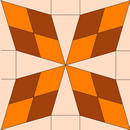 Cowboy's Star Cowboy's Star
Kansas City Star
1932And here you thought you were finished with Cowboy's Stars.
At left, we've traced Evelyn Foland's variation from a 1932 Kansas City Star. Compared to the others, Foland's has far wider cockeyed checkerboards (four-piece diamonds, if you must).
Our tracing is a bit irregular (although less so than the KCS illustration). To make a block with similar proportions, we recommend using the pattern for Page's block, below.
Once we get back our Curves section, we plan to add the Cowboy's Star by Laura Wheeler and the very similar Chimney Swallow by Nancy Cabot. |
|
Cowboy's Star
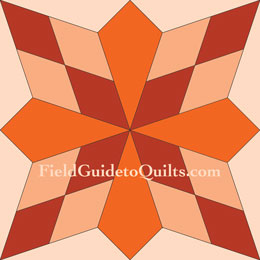 Cowboy's Star Cowboy's Star
Page
1938
 Arkansas Traveler/Travel Star Arkansas Traveler/Travel Star
Columnist Nancy Page provided a new and far simpler Cowboy's Star for Birmingham News readers in 1938.
Page's star is drawn on an 8x8 grid — much easier for a reader to reproduce for her own quilt than a star-grid block. While we haven't seen the original column, we think it calls for four colors.
We've posted a diagram for you to use as a pattern. Just click on the purple icon.
|
 Cowboy's Star (Page) Cowboy's Star (Page)
|
|
Job's Troubles
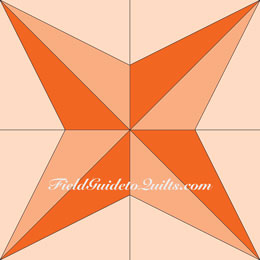 Job's Troubles
Origin unknown Job's Troubles
Origin unknown
 This variation of Job's Troubles is from the web. It's on a 4x4 grid and looks as though it has been around forever, but if it has, no one has yet laid claim to the design. This variation of Job's Troubles is from the web. It's on a 4x4 grid and looks as though it has been around forever, but if it has, no one has yet laid claim to the design.
It's simple to make if you don't mind sewing on the bias — or if you want to practice. You can download a pattern from Scissortail Quilting Company by clicking on the blue "Make It!" link.
|
                Job's Troubles Job's Troubles |
|
Milkmaid's Star
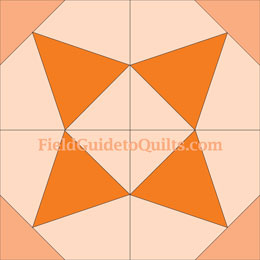 Milkmaid's Star
Kansas City Star Milkmaid's Star
Kansas City Star
1948
For such a simple block, Milkmaid's Star makes a highly effective whole quilt whether it's in three colors or two, as it was originally published.
The Star credited the block to Audrey Ellis of Minturn, Arkansas.
What really cracked us up, though, was the Star's note about "the easily interpreted diary theme."
They're saying that the points look like udders. |
               
Milkmaid's Star |
|
Crossed Canoes
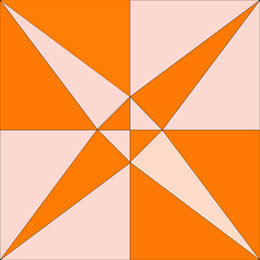 Crossed Canoes
Ladies Art Co., #89 1897 Crossed Canoes
Ladies Art Co., #89 1897
This handsome design dates back to the Ladies Art Company catalog of 1897 (#89). It is drawn on an 8x8 grid. |
               
Crossed Canoes (LAC) |
|
Crossed Canoes
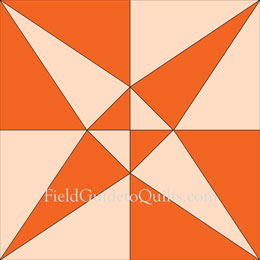 Crossed Canoes
Kansas City Star Crossed Canoes
Kansas City Star
1929  The Dragon Fly/Indian Canoes/Two Canoes The Dragon Fly/Indian Canoes/Two Canoes
Crossed Canoes is from a 1929 Kansas City Star, which republished it as The Dragon Fly in 1936 and 1954. Nancy Cabot and Nancy Page called it Indian Canoes and Two Canoes in 1936 and 1940, respectively. The block is drawn on a 6x6 grid.
One point of interest to fanatics: While Beyer's Quilter's Album says that The Dragonfly is on a 10x10 grid, it is drawn to different grid points from Indian Canoes, below, and, to our eyes, is all but identical to the Star's.
Now that that's off our chest, we can carry on. |
               
Crossed Canoes (KCS)
|
|
Indian Canoes
 Indian Canoes
Kansas City Star Indian Canoes
Kansas City Star
1933
Perhaps it was the belt-tightening zeitgeist of the times that inspired the Star to print this Crossed Canoes variation on a 10x10 grid. And perhaps that's why it's the only time that the Star published Indian Canoes.
|
               
Indian Canoes (KCS)
|
|
Wyoming Patch
 Wyoming Patch Wyoming Patch
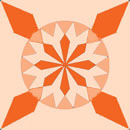 Wyoming Patch
LAC, #494 Wyoming Patch
LAC, #494
1922
The Wyoming Patch was in the Ladies Art Company catalog of 1922 as #494. The LAC showed the block in only two colors, but we've added a third shade to show the seams.
The name Texas Sunflower is from Comfort magazine, according to Barbara Brackman's Encyclopedia of Pieced Quilt Patterns.
|
|
|
 |
|

